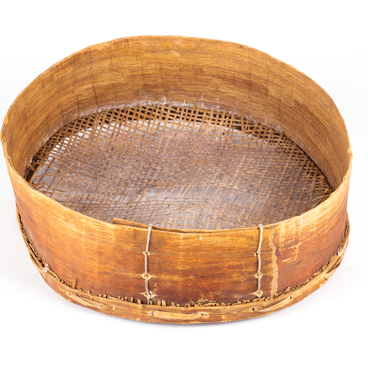Like the inner space in a yurt, the interior of the traditional Bashkir hut was distinguished by simplicity and rationality. Low, spacious wooden bunks built into the wall opposite the entrance occupied a central spot in it. At night they slept on them, and during the day all the bedding was transferred to a chest that was set on a decorated stand. Very valuable things were put on the chest: rugs, unnapped woven rugs, blankets, and pillows. This heap of blankets and pillows could reach the ceiling, and so it did not fall over it was pulled together with a patterned ribbon, the torma-bau, with colored decoration on a red or black background.
The tortma-bau is a decorative ribbon embellished with embroidery ranging from 12–17 centimeters wide, and 1.5 meters in length or longer. The ornamentation for this kind of ribbon included coins, color, and braiding in the form of gold or silver braids. Beads strung on threads were attached to the wide edge trimming on the tortma-bau, and woolen tassels were sewn on. The ribbon began with a semioval, similar to a girl’s headdress, and at the bottom ended with fringing. Instead of velvet and cloth, sateen (most often black) was also used in the post-war period. Red calico fabric was often used for the trimming. The ribbons were embroidered with colored mouline threads.
Embroidery is one of the main types of traditional arts and crafts for the Bashkirs, so the torma-baus, tobacco pouches, men’s and women’s fabric clothing, saddlecloths, and other items were richly decorated with it. Most frequently, a combination of ordinary and double chain stitching was used — this is the most characteristic type of Bashkir national embroidery. Usually, the Bashkir people embroidered patterns on a red or green background, but black could also be encountered. For the patterns themselves, colors with warm overtones were chosen, and most often those were yellow and green colors, with light blue and dark blue much less frequently. Red, which is very popular in Bashkir embroidery, was often found even on patterns that already had a red background.
The tortma-bau was also decorated with so-called kuskar embroidery, which is characterized by decorative forms similar to a ram’s horn. This ornamentation symbolizes fertility, and was designed to protect the owner’s bed from the evil eye. The surface of the kurkar figure, located in the center, was filled with red, green, and yellow threads. Woolen threads were used to accomplish this.
The tortma-bau is a decorative ribbon embellished with embroidery ranging from 12–17 centimeters wide, and 1.5 meters in length or longer. The ornamentation for this kind of ribbon included coins, color, and braiding in the form of gold or silver braids. Beads strung on threads were attached to the wide edge trimming on the tortma-bau, and woolen tassels were sewn on. The ribbon began with a semioval, similar to a girl’s headdress, and at the bottom ended with fringing. Instead of velvet and cloth, sateen (most often black) was also used in the post-war period. Red calico fabric was often used for the trimming. The ribbons were embroidered with colored mouline threads.
Embroidery is one of the main types of traditional arts and crafts for the Bashkirs, so the torma-baus, tobacco pouches, men’s and women’s fabric clothing, saddlecloths, and other items were richly decorated with it. Most frequently, a combination of ordinary and double chain stitching was used — this is the most characteristic type of Bashkir national embroidery. Usually, the Bashkir people embroidered patterns on a red or green background, but black could also be encountered. For the patterns themselves, colors with warm overtones were chosen, and most often those were yellow and green colors, with light blue and dark blue much less frequently. Red, which is very popular in Bashkir embroidery, was often found even on patterns that already had a red background.
The tortma-bau was also decorated with so-called kuskar embroidery, which is characterized by decorative forms similar to a ram’s horn. This ornamentation symbolizes fertility, and was designed to protect the owner’s bed from the evil eye. The surface of the kurkar figure, located in the center, was filled with red, green, and yellow threads. Woolen threads were used to accomplish this.



